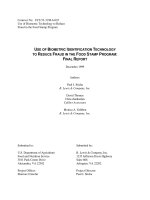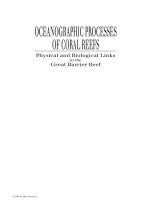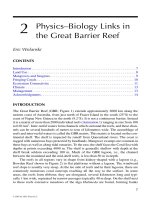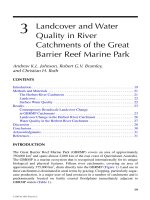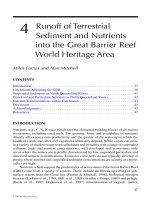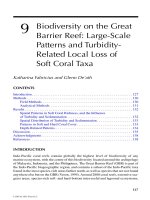Bacterial cellulose assisted synthesis of hierarchical pompon-like SAPO-34 for CO2 adsorption
Bạn đang xem bản rút gọn của tài liệu. Xem và tải ngay bản đầy đủ của tài liệu tại đây (10.11 MB, 8 trang )
Microporous and Mesoporous Materials 331 (2022) 111664
Contents lists available at ScienceDirect
Microporous and Mesoporous Materials
journal homepage: www.elsevier.com/locate/micromeso
Bacterial cellulose assisted synthesis of hierarchical pompon-like SAPO-34
for CO2 adsorption
Jie Gong a, Fei Tong a, Chunyong Zhang a, Mojtaba Sinaei Nobandegani b, Liang Yu b, *,
Lixiong Zhang c, **
a
b
c
College of Chemical and Environmental Engineering, Jiangsu University of Technology, Changzhou, 213001, Jiangsu, PR China
Chemical Technology, Luleå University of Technology, SE-971 87 Luleå, Sweden
State Key Laboratory of Materials-Oriented Chemical Engineering, College of Chemistry and Chemical Engineering, Nanjing Tech University, Nanjing, 210009, PR China
A R T I C L E I N F O
A B S T R A C T
Keywords:
Hierarchical pompon-like SAPO-34
Biosynthesis route
Bacterial cellulose
CO2 adsorption
In the present work, a biosynthesis route for the preparation of hierarchical pompon-like SAPO-34 was devel
oped. Commercially available bacterial cellulose aerogel was used as template. SiO2 loaded bacterial cellulose
aerogel was used as silica source and a simple hydrothermal treatment was used for crystallization. XRD, FT-IR,
SEM, TEM, N2 adsorption-desorption and TG techniques were employed to characterize the obtained samples.
The hierarchical pompon-like SAPO-34 showed a spherical morphology that was comprised of nanosheets with a
thickness less than 30 nm. The specific surface area of the hierarchical pompon-like SAPO-34 was 498 m2/g that
was higher than the trigonal SAPO-34 crystals of 465 m2/g. The ultrasonic treatment experiment indicated a high
stability of the pompon-like structure. In addition, the hierarchical pompon-like SAPO-34 exhibited a CO2
adsorption capacity of 2.26 mmol/g at 100 kPa and 298K and the corresponding CO2/CH4 ideal separation factor
was 5.7, which was higher than that of trigonal SAPO-34 crystals. The saturated adsorption capacity and b-value
were estimated using single site Langmuir, Toth and Sips adsorption isotherm models and the observed results
were constant. Compared with trigonal SAPO-34, hierarchical pompon-like SAPO-34 displayed a higher satu
rated adsorption capacity, but a lower b-value.
1. Introduction
Biogas and natural gas with the main components of CO2 and CH4 are
environmentally friendly fuels and feedstocks. The CO2 concentration in
raw biogas and natural gas can be as high as 45% and 25%, respectively
[1,2]. CO2 will reduce energy density, causing it to miss the pipeline
quality requirement for minimum heating value [3] and react with
water to form a corrosive acid, leading to pipeline corrosion [4].
Therefore, to reach the required fuel and grid specifications, removal of
CO2 from biogas and natural gas is necessary.
Silicoaluminophosphate (SAPO) zeolite SAPO-34 with a CHA
framework structure has eight-membered rings defined threedimensional pore system. The pore size is about 3.8 Å [3], which is
larger than the molecular size of CO2 (3.3 Å) and similar to that of CH4
(3.8 Å) [3]. Consequently, SAPO-34 could be used to separate CO2 from
natural gas and biogas by molecular sieving. Besides, due to the small
pores, moderate acidity and high thermal/hydrothermal stability,
SAPO-34 has also been used as catalyst in various reactions [5–7].
However, the sole presence of micropores in SAPO-34 slows down the
mass transfer to and from active sites located within the micropores,
which would limit the reaction rate and lead to the rapid deactivation of
the catalyst. This restricts the use of SAPO-34 for practical applications.
To overcome the limitation and increase the mass transfer, many
efforts have been taken to fabricate hierarchical SAPO-34 in recent years
[3–20]. Moreover, hierarchical zeolites contain more than one types of
pores with different sizes and the larger pores could improve the mass
transfer. The hard and soft template methods have been considered as
efficient methods for the preparation of hierarchical SAPO-34 [9–20].
Carbon materials are the most common hard template [9–11]. However,
carbon materials are usually hydrophobic and may lead to the weak
interaction with the synthesis gel. Compared with hard templates, soft
templates with three-dimensional network structures, abundant func
tional groups and designed molecular sizes demonstrate great signifi
cance on the synthesis of hierarchical SAPO-34 [8]. So far, polymers,
* Corresponding author.
** Corresponding author.
E-mail addresses: (L. Yu), (L. Zhang).
/>Received 26 October 2021; Received in revised form 18 December 2021; Accepted 27 December 2021
Available online 29 December 2021
1387-1811/© 2021 The Authors.
Published by Elsevier Inc.
This is an open access
( />
article
under
the
CC
BY-NC-ND
license
J. Gong et al.
Microporous and Mesoporous Materials 331 (2022) 111664
like PEG [12], PEI [13] and PAM [14], and surfactants, like DMOD [15],
CTAB [16], PDADMAC [17] and TPOAC [18,19] have been used to
synthesize hierarchical SAPO-34. Liu [20] et al. designed a new sur
factant (DPHAB) for the synthesis of hierarchical SAPO-34. The obtained
SAPO-34 displayed a hierarchical structure with pore size in the range of
2–46 nm, and the surface area reached to 673 m2/g. However, such
uncommon surfactants are expensive and non-renewable, restricting
their applications [8,20].
Our group has developed efficient methods to prepare hierarchical
structure zeolitic materials, by using biomaterial e.g. chitosan [21,22],
gelatin [23], rapeseed pollen [24] and its extract [25] as templates. For
instance, by using pollen as a template, we have successfully prepared
hollow hierarchical ZSM-5 as well as the other porous inorganic mate
rials [24]. Biomass chitosan has also been used for the preparation of
zeolite A/CS xerogel hybrid films due to its unique hydrogel network
structure [22]. SAPO-34 with a unique morphology of curly nanosheets
was synthesized when rapeseed pollen extract was used to prepare the
synthesis solution, and showed a higher CO2 adsorption capacity and
efficiency [25]. The SAPO-34 also displayed a hierarchical structure.
Bacterial cellulose (BC) with high porosity, water retention capa
bility, mechanical properties, formability, and biocompatibility, has
been used as additive of food and medical materials, as well as in optical,
electronic, and optoelectronic devices [26]. Due to the interconnected
networks of BC nanofibers with diameters ranging from 5 to 100 nm
[26], they have been used as templates to synthesize various inorganic
hollow fiber materials or nanoparticles, such as oxide [27–29], MOFs
[30], zeolite NaA [31], MFI [32,33], etc. So far, however, its application
in SAPO-34 synthesis has rarely been reported. Besides, BC is an
economical template that produced in large amounts in a microbial
fermentation process.
In the present work, we report a hydrothermal synthesis route to
simply prepare hierarchical pompon-like SAPO-34 using BC as template.
SiO2 loaded BC aerogel were prepared and used as silicon source to
prepare SAPO-34. The obtained hierarchical SAPO-34 was deeply
characterized and compared with the conventional SAPO-34 crystals.
The hierarchical pompon-like SAPO-34 crystals were composed of
zeolite nanosheets with a thickness of less than 30 nm. To the best of our
knowledge, hierarchical SAPO-34 comprised of 2D zeolite nanosheets
structure has not been reported by other groups. The adsorption per
formance of the SAPO-34 for CO2 and CH4 was also studied.
In addition, preparation of 2D zeolite nanosheets has gained much
attention due to the application of nanosheets in membrane preparation
[34–36]. 2D zeolite nanosheets are mainly achieved by exfoliating
layered zeolite precursors [35]. Zeolite nanosheets, including MWW and
MFI structure types have been successfully fabricated by Tsapatsis’s
group [37,38]. The zeolite nanosheets could be coated on porous sub
strates to form well-packed thin deposits layer that exhibited excellent
molecular sieving properties [37]. These results displayed a great po
tential of zeolite nanosheets. Therefore, the preparation of SAPO-34
crystals comprising of nanosheets is of great interest.
phosphoric acid (85 wt%, Sinopharm Chemical Reagent Co., Ltd.) and
0.79 g of aluminum isopropoxide (Aladdin) were added into 10.0 g of
deionized water and stirred until dissolved completely. Afterwards,
0.077 g of SiO2/BC was added into the solution and followed by stirring
for 3 h. Finally, 0.97 g of triethylamine (TEA, 99 wt%, Sinopharm
Chemical Reagent Co., Ltd.) was added. The molar composition of the
mixture was Al2O3:P2O5:0.6SiO2:5TEA:300H2O. The mixture was
further stirred for 24 h at room temperature, and then transferred into a
40 ml autoclave for hydrothermal synthesis. The hydrothermal synthesis
was performed at 200 ◦ C for 72 h. The as-synthesized products were
recovered by centrifuge, and washed with deionized water for several
times. The sample was dried at 80 ◦ C overnight.
SAPO-34 without using BC aerogel was also prepared. Silica powder
that was prepared by freeze-drying silica sol (30 wt%) was used as the
silica source. The other procedures were the same as described above. In
addition, SAPO-34 was also synthesized by using 30 wt% silica sol
directly. Finally, all the products were calcined at 550 ◦ C for 5 h under
air atmosphere. The heating rate was 1 ◦ C/min. The obtained samples
were noted as S (prepared with SiO2/BC), S’ (prepared with silica sol)
and S’’ (prepared with silica powder).
2.2. Characterizations
X-ray diffraction (XRD) patterns were collected at 40 kV and 40 mA
on a Bruker D8 Advance powder diffractometer using a Cu Kα radiation
source. A Braun position sensitive detector was used and the scan rate
was 5◦ /min and the step size was 0.05◦ . The Fourier transform infrared
spectra (FT-IR) were obtained on a Nexus 870 FT-IR spectrometer in the
wavenumber range of 4000–400 cm− 1. The samples were mixed with
KBr (in a mass ratio of 1:10) and pressed to pellets for FT-IR measure
ment. Scanning electron microscope (SEM, Hitachi S-4800) and trans
mission electron microscope (TEM, JEL-200CX) were used to investigate
the particle size, morphology and microstructure of the samples. The Si,
Al and P contents of SAPO-34 were analyzed by an energy dispersive Xray analyzer (EDX, Sigma) attached to the SEM (Quanta 200). N2
adsorption-desorption isotherms were measured at 77 K on a Micro
meritics ASAP 2020 instrument. The samples were all degassed at 300 ◦ C
for 10 h before measurement. Thermogravimetric (TG) analysis was
carried out in an air atmosphere using a Netzsch STA 409 instrument.
The sample was heated to 800 ◦ C from room temperature with a heating
rate of 10 ◦ C/min. The sample was maintained at the final temperature
for 20 min. Alumel calibration standard was used to calibrate the TGA
instrument.
2.3. Adsorption experiments
Gas adsorption measurements of CO2 and CH4 were performed at
298 K and pressures up to 100 kPa on a Micromeritics ASAP 2020 in
strument. The samples were all degassed at 300 ◦ C for 10 h before the
measurement. The ideal separation factor of CO2 over CH4 was calcu
lated as the ratio of the molar adsorption amount of CO2 and CH4
measured at the same pressure and temperature.
2. Experimental
2.1. Preparation of hierarchical pompon-like SAPO-34
2.4. Modeling of gas adsorption over SAPO-34 crystals
Firstly, purified BC pellicles with a fiber content of about 1% (vol/
vol) (Hainan Guangyu Biotechnology Co., Ltd.) were cut into 2 cm × 2
cm pieces and washed with deionized water several times before use. BC
aerogel was obtained after freeze drying for 24 h. To prepare silica/BC
aerogel, the BC aerogel were immersed into an excessive silica sol (30 wt
%, Zhejiang Yuda Chemical Industry Co., Ltd.) and maintained for 12 h.
Afterwards, the obtained silica sol/BC aerogel was freeze dried to
remove water. The processes were repeated several times until the
content of silica in silica/BC aerogel was about 98 wt%. The silica/BC
aerogel was grounded (noted as SiO2/BC) and used as silicon source.
For the preparation of hierarchical pompon-like SAPO-34, 0.44 g of
The measured adsorption isotherms were fitted by single site Lang
muir adsorption isotherm using equation (1):
C = Csat
bP
1 + bP
(1)
Where C and Csat represent the adsorbed amount and saturated
adsorption capacity, respectively. b is the affinity constant, and P is the
pressure. The saturated adsorption capacity was estimated by fitting the
Langmuir model to the adsorption data. The R-squared values, R2, were
used to show the goodness-of-fit. Meanwhile, b-values and saturated
2
J. Gong et al.
Microporous and Mesoporous Materials 331 (2022) 111664
adsorption capacities were obtained for different samples and gases,
respectively.
In addition, Toth (equation (2)) and Sips (equation (3)) adsorption
isotherms were also employed to fit the adsorption data. For Toth Model,
the adsorption concentration is estimated as:
C=
bP
/ Csat
1
[
t] t
1 + (bP)
nanosheets are stacked with irregular pores of about 30 nm in diameters
in between the nanosheets (Fig. 3b). It has been reported that the
chemical formula of SAPO-34 is (SixAlyPz)O2 (x = 0.01–0.98, y =
0.01–0.60, z = 0.01–0.52, and x + z = y) [39]. The EDX results (Table 1)
show that sample S has a decent Si:Al:P ratio as described in the
chemical formula. This result indicates that there is no amorphous in the
sample and the SAPO-34 has high crystallinity. This is in line with XRD
results. Moreover, sample S shows the highest Si content in the three
samples. It resulted from using silica/BC as a silicon source. In silica/BC,
silica particles are fixed on or between the BC nanofibers through
hydrogen bonding between hydroxyl groups of BC and silica particles
[40], and phosphoric acid and aluminum isopropoxide diffuse into it to
form gel for zeolite synthesis. In this case, the percentage of silica in the
gel will be higher than that in the synthesis mixture. Therefore, higher
silicon content in pompon-like SAPO-34. This process is similar to the
preparation of zeolite A/chitosan microspheres by diffusing sodium
aluminate into the silica/chitosan microspheres that could maximize the
conversion of silica [41]. Sample S′ and sample S′′ prepared with silica
sol and silica powder showed the same structure as indicated by XRD
and FT-IR (Fig. 1a and b) results. However, the morphology is
completely different as compared to sample S. It seems like that only
classical pseudo-cubic crystals were observed in S’ (Fig. 3d) and some
amorphous was observed in sample S’’ (Fig. 3c).
TEM images of sample S are shown in Fig. 4. The network structure
and the pores between the nanosheets can be observed clearly (Fig. 4a).
The ultra-thin nanosheet can be seen clearly from the edge of the sample
at high magnification (see Fig. 4b). The internal structure of sample S
was also investigated by SEM. Before investigation, the sample was
treated by ultrasonic for 2 h and 6 h, respectively. The broken part of the
zeolite after ultrasonic treatment for 2 h shows that the internal of the
zeolite is also composed of nanosheets (Fig. 4c). The sample after ul
trasonic treatment for 6 h still shows a nanosheets comprised structure
(Fig. 4d), which indicated a high stability.
Fig. 5a shows a TG curve of uncalcined sample S and S’. A three-stage
weight loss was observed for both samples. The first one occurred before
150 ◦ C with a weight loss of 5.72 wt% for samples S. It can be ascribed to
water desorption. However, sample S’ shows a less weight loss of 3.70
wt%. The difference in weight loss could be ascribed to that BC may
absorb water from the air. The second weight loss of sample S occurs at
temperatures between 150 and 440 ◦ C with a large weight loss of 8.83
wt%, which mainly contributed by thermal decomposition of BC. The
third weight loss occurs at temperatures between 440 and 650 ◦ C with a
weight loss of 4.62 wt%, which was ascribed to the further decompo
sition/oxidation of TEA. Fig. 5b shows the TG curve of BC. The results
indicate that BC could be easily removed (at temperature >300 ◦ C) from
SAPO-34 zeolite.
(2)
where, t is the Toth heterogeneity parameter.
Sips model is defined as:
/
1
C=
n
(bP)
/ Csat
1
1 + (bP)
(3)
n
where n is a dimensionless parameter that accounts the heterogeneity of
the system. However, when t and n approach one, Toth and Sips
adsorption isotherms show similar behavior as single site Langmuir
adsorption isotherm.
3. Results and discussion
XRD pattern of the sample S (Fig. 1a) prepared with SiO2/BC exhibits
characteristic diffraction peaks of SAPO-34 as compared with the
reference pattern [39]. No extra peak was observed. The relative in
tensity of (100) peak at 9.6◦ was stronger compared to that of sample S′
and sample S′′ , which probably resulted from the unique structure.
Fig. 1b shows the FT-IR spectrum of sample S, S′ and S’’. The absorption
bands at 480, 530, 565 and 635 cm− 1 indicate a CHA structure [14].
However, the SiO4 band at 480 cm− 1 and PO4 band at 565 cm− 1 slightly
shift to 495 and 555 cm− 1 for sample S, which may be affected by the
introduction of BC.
Fig. 2 shows the SEM images of BC aerogels and SiO2/BC. The SEM
image of BC aerogels exhibits a porous, interconnected and sophisti
cated three-dimensional porous network structure (Fig. 2a) that are
composed of numerous nanofibers. The diameter of the nanofibers is
about 20–80 nm (Fig. 2b). After being saturated with SiO2, the SEM
clearly shows that the nanofibers are embodied by SiO2 (Fig. 2c), and the
morphology of BC nanofiber was preserved in SiO2/BC (Fig. 2d).
Fig. 3 shows the SEM images of SAPO-34 samples prepared from
different silica sources. The SEM image at low magnification (Fig. 3a)
shows that sample S is of pompon-like spherical morphology with an
average particle size of about 2 μm. The high magnification SEM image
(see Fig. 3b) shows the as-synthesized SAPO-34 are composed of nano
sheets. The thickness of the nanosheets is less than 30 nm. The
Fig. 1. (a) XRD patterns and (b) FT-IR spectra of sample S, S′ and S’‘.
3
J. Gong et al.
Microporous and Mesoporous Materials 331 (2022) 111664
Fig. 2. SEM images of BC (a, b) and SiO2/BC (c, d) at different magnifications.
Fig. 3. SEM images of sample S at different magnifications (a, b), and sample S’ (c) and sample S’’ (d).
4
J. Gong et al.
Microporous and Mesoporous Materials 331 (2022) 111664
[25]. This is in line with the observation of SEM, where nanosheets
structure was obtained and the closely compacted nanosheets generated
slit shaped mesopores. The surface area of sample S is 498 m2/g, higher
than 465 m2/g of sample S’’. Fig. 6b shows the pore size distribution that
calculated by the Barrett-Joyner-Halenda (BJH) method using desorp
tion branches of isotherms. The curve shows a narrow pore size distri
bution with the peak centered at 3.7 nm. The results confirm the
mesopores in the sample, which indicates a hierarchical structure of the
pompon-like SAPO-34.
The adsorption isotherms of sample S and S′ for CO2 and CH4 at 298
K are presented in Fig. 7. The adsorption isotherms follow the type I
isotherms based on Brunauer classification [42], which is a typical class
of isotherm for the adsorption over microporous materials. Apparently,
sample S exhibits a higher CO2 adsorption capacity and the CO2 and CH4
adsorption capacities were 2.26 and 0.40 mmol/g at 100 kPa (Fig. 7a),
Table 1
Al, P, and Si contents in sample S, S′ and S′′ measured by EDX.
Sample
S
S′
S′′
Al
P
Si
Atom %
Atom %
Atom %
48.2
49.6
53.0
28.8
36.6
37.1
23.0
13.8
9.9
Fig. 6a shows the N2 adsorption-desorption isotherms of the calcined
sample S and S’. Both isotherms exhibit high uptake at the initial pres
sure range, which results from the microporous structure of SAPO-34
zeolite. The hysteresis loop at P/P0 = 0.45–0.99 indicates a meso
porous structure in sample S. Moreover, the hysteresis loop belongs to
H4 type and H4 type isotherm mainly results from slit shaped mesopores
Fig. 4. TEM images of sample S at low (a) and high (b) magnification. SEM images of sample S with ultrasonic treatment for 2 h (c) and for 6 h (d).
Fig. 5. TG curves of (a) sample S and S′ , (b) TG curve of BC.
5
J. Gong et al.
Microporous and Mesoporous Materials 331 (2022) 111664
Fig. 6. (a) Nitrogen adsorption-desorption isotherms of sample S and S’. (b) BJH pore size distribution of sample S.
Fig. 7. Adsorption isotherms of CO2 and CH4 on sample S (a) and sample S’ (b) at 298 K. Points show the measured data and curves represent the fitted model.
respectively. The corresponding CO2/CH4 ideal separation factor was
5.7. It has been reported that the heats of adsorption of CO2 and CH4 on
CHA zeolites are about − 25 and − 17 kJ/mol, respectively [43–45]. The
higher heat of adsorption for CO2 results from the basicity of the zeolite
framework [46] and larger polarity of CO2 molecules, which increases
the affinity between CO2 and zeolite, thereby more CO2 selective. At the
same conditions, sample S′ displayed a CO2 and CH4 adsorption capacity
of 2.04 and 0.46 mmol/g (Fig. 7b), respectively, which corresponds to a
CO2/CH4 ideal separation factor of 4.4. The hierarchical pompon-like
SAPO-34 showed a higher ideal separation factor of CO2/CH4, which
could be ascribed to the nanosheet structure that generates more
accessible pores and a higher surface area [47–49]. Furthermore, as
indicated by EDX analysis (see Table 1), the content of silicon was higher
in sample S compared to that of sample S’, which increases Brønsted acid
sites and provides more energetic adsorption sites for CO2 adsorption
[50,51]. Consequently, sample S showed a high CO2 adsorption capac
ity. The results are consistent with the results of CO2 adsorption on
SAPO-34 reported by Liu [3] and Maurin [52].
Fig. 7 shows that the single site Langmuir adsorption isotherm could
fit the adsorption data well. The R-squared values (see Table 2) were
higher than 0.998 for all cases. The estimated saturated adsorption ca
pacity for CO2 was 4.05 mmol/g for sample S that was much higher than
that for samples S’. The estimated b-values of CO2 was higher than that
of CH4 because of the large polarizability of CO2, i.e. CO2 has higher
affinity to the zeolite compared to CH4. Interestingly, the estimated bvalues of sample S′ were higher than that of samples S. It is due to the
high aluminum content in sample S′ as shown in Table 1. The modeling
further confirmed that the higher CO2 adsorption capacity for
Table 2
Fitted parameters by Single site Langmuir, Toth, and Sips adsorption isotherms for the adsorption of CO2 and CH4 on samples S and S’.
Zeolites
Gas components
Adsorption isotherms
Csat (mmol/g)
Heterogeneity parameter
b-value (Pa− 1)
S
CO2
Langmuir
Toth
Sips
Langmuir
Toth
Sips
Langmuir
Toth
Sips
Langmuir
Toth
Sips
4.05
4.07
4.06
2.25
2.22
2.23
2.95
3.11
2.91
1.91
1.98
1.95
n/a
0.9810
0.9996
n/a
0.9435
0.9953
n/a
0.9126
0.9963
n/a
0.9969
0.9798
1.30 × 10−
1.28 × 10−
1.26 × 10−
2.20 × 10−
2.30 × 10−
2.20 × 10−
2.20 × 10−
2.20 × 10−
2.26 × 10−
3.20 × 10−
3.00 × 10−
3.20 × 10−
CH4
S′
CO2
CH4
6
5
5
5
6
6
6
5
5
5
6
6
6
R-Square
0.9999
0.9999
0.9999
0.9991
0.9986
0.9991
0.9980
0.9988
0.9981
0.9989
0.9999
0.9999
Microporous and Mesoporous Materials 331 (2022) 111664
J. Gong et al.
hierarchical pompon-like SAPO-34 was a result of the higher surface
area. Table 2 shows the fitted parameters for the adsorption of CO2 and
CH4 on samples S and S’ using single site Langmuir adsorption isotherm.
Table 2 also summarizes the fitted parameters by Toth and Sips
adsorption isotherms. The results show that the Toth and Sips adsorption
isotherms could also fit the adsorption well (the curves of the fitted
model are not shown here). The obtained saturated adsorption capac
ities and b-values were similar as the ones from the single site Langmuir
adsorption isotherm. All heterogeneity parameters were also close to
one, which indicates a homogeneous surface of the samples.
[7]
[8]
[9]
[10]
4. Conclusions
In summary, hierarchical pompon-like SAPO-34 with a particle size
of about 2 μm has been successfully synthesized by a simple hydro
thermal treatment. Use SiO2 loaded BC as a silica source is crucial for the
synthesis. The method is simple, and the BC template is economical and
environmentally friendly. The hierarchical pompon-like SAPO-34 par
ticles were comprised of nanosheets with a thickness less than 30 nm.
The hierarchical pompon-like SAPO-34 exhibited a higher CO2 adsorp
tion capacity and a higher ideal CO2/CH4 separation factor compared to
the conventional trigonal SAPO-34 crystals due to the higher surface
area. In addition, due to the unique structure, the nanosheet can prob
ably be exfoliated and used for the preparation of ultra-thin CHA
membranes, which could be a new insight into CHA nanosheet
membranes.
[11]
[12]
[13]
[14]
[15]
CRediT authorship contribution statement
Jie Gong: Investigation, Methodology, Project administration,
Writing – original draft. Fei Tong: Investigation. Chunyong Zhang:
Data curation, Resources. Mojtaba Sinaei Nobandegani: Formal
analysis. Liang Yu: Formal analysis, Supervision, Writing – review &
editing. Lixiong Zhang: Supervision, Project administration, Funding
acquisition.
[16]
[17]
[18]
Declaration of competing interest
The authors declare that they have no known competing financial
interests or personal relationships that could have appeared to influence
the work reported in this paper.
[19]
[20]
Acknowledgements
We are grateful for financial support from the National & Local Joint
Engineering Research Center for Deep Utilization Technology of Rocksalt Resource (SF201804) and Jiangsu University of Technology
(11610412042). We also thank Hainan Guangyu Biotechnology Co., Ltd.
for voluntary bacterial cellulose.
[21]
[22]
References
[23]
[1] H.G. Katariya, H.P. Patolia, Advances in Biogas Cleaning, Enrichment, and
Utilization Technologies: a Way Forward, Biomass Conv. Bioref, 2021, https://doi.
org/10.1007/s13399-021-01750-0.
[2] R.W. Baker, Future directions of membrane gas separation Technology, Ind. Eng.
Chem. Res. 41 (2002) 1393–1411, />[3] D.H. Wang, P. Tian, M. Yang, S.T. Xu, D. Fan, X. Su, Y. Yang, C. Wang, Z.M. Liu,
Synthesis of SAPO-34 with alkanolamines as novel templates and their application
for CO2 separation, Microporous Mesoporous Mater. 194 (2014) 8–14, https://doi.
org/10.1016/j.micromeso.2014.03.028.
[4] Y. Zhang, J. Sunarso, S.M. Liu, R. Wang, Current status and development of
membranes for CO2/CH4 separation: a review, Int. J. Greenh. Gas Control 12
(2013) 84–107, />[5] Y.R. He, Y.L. Zhu, Y. Duan, M. Zhang, J.X. Jiang, Green route to grow hierarchical
SAPO-34 crystal with excellent catalytic performance in methanol to olefin
reaction, Cryst. Growth Des. 20 (2020) 17–23, />cgd.9b01257.
[6] P.X. Rui, B.R. Wang, F.B. Chen, Y.J. Xiang, J.M. Yang, T. Guo, Z. Wu, W.L. Liao, X.
T. Shu, The hydrothermal synthesis of hierarchical SAPO-34 with improved MTO
[24]
[25]
[26]
[27]
7
performance, New J. Chem. 45 (2021) 11093–11100, />D1NJ01066B.
Y.Y. Mi, G. Li, Y.L. Zheng, Y.W. Luo, W.M. Liu, Z.G. Li, D.S. Wu, H.G. Peng, Insights
into novel mesoporous Cu-SAPO-34 with enhanced deNOx performance for diesel
emission control, Microporous Mesoporous Mater. 323 (2021), 111245, https://
doi.org/10.1016/j.micromeso.2021.111245.
J.W. Zhong, J.F. Han, Y.X. Wei, P. Tian, X.W. Guo, C.S. Song, Z.M. Liu, Recent
advances of the nano-hierarchical SAPO-34 in the methanol-to-olefin (MTO)
reaction and other applications, Catal. Sci. Technol. 7 (2017) 4905–4923, https://
doi.org/10.1039/C7CY01466J.
F. Schmidt, S. Paasch, E. Brunneet, S. Kaskel, Carbon templated SAPO-34 with
improved adsorption kinetics and catalytic performance in the MTO-reaction,
Microporous Mesoporous Mater. 164 (2012) 214–221, />micromeso.2012.04.045.
J. Wang, M.F. Yang, W.J. Shang, X.P. Su, Q.Q. Hao, H.Y. Chen, X.X. Ma, Synthesis,
characterization, and catalytic application of hierarchical SAPO-34 zeolite with
three-dimensionally ordered mesoporous imprinted structure, Microporous
Mesoporous Mater. 252 (2017) 10–16, />micromeso.2017.06.012.
A.Z. Varzaneh, J. Towfighi, M.S. Moghaddam, Synthesis of zirconium modified
hierarchical SAPO-34 catalysts using carbon nanotube template for conversion of
methanol to light olefins, Petrol. Chem. 60 (2020) 204–211, />10.1134/S0965544120020097.
S.C. Zhang, Z.Y. Wen, L. Yang, C.H. Duan, X.P. Lu, Y.B. Song, Q.J. Ge, Y.W. Fang,
Controllable synthesis of hierarchical porous petal-shaped SAPO-34 zeolite with
excellent DTO performance, Microporous Mesoporous Mater. 274 (2019) 220–226,
/>F. Wang, L. Sun, C.L. Chen, Z. Chen, Z.W. Zhang, G.H. Wei, X.M. Jiang,
Polyethyleneimine templated synthesis of hierarchical SAPO-34 zeolites with
uniform mesopores, RSC Adv. 4 (2014) 46093–46096, />C4RA08199D.
L. Han, L.L. Guo, S.Z. Xue, Z. Wang, T.L. Lu, J. Xu, Y.Z. Zhan, J.F. Wang,
Polyacrylamide-assisted synthesis of hierarchical porous SAPO-34 zeolites with
excellent MTO catalytic performance, Microporous Mesoporous Mater. 311 (2021),
110676, />S.H. Newland, W. Sinkler, T. Mezza, S.R. Bare, M. Carravetta, I.M. Haies, A. Levy,
S. Keenan, R. Raja, Expanding beyond the micropore: active-site Engineering in
hierarchical architectures for Beckmann rearrangement, ACS Catal. 5 (2015)
6587–6593, />I. Miletto, G. Paul, S. Chapman, G. Gatti, L. Marchese, R. Raja, E. Gianotti,
Mesoporous silica scaffolds as precursor to drive the formation of hierarchical
SAPO-34 with tunable acid properties, Chem. Eur J. 23 (2017) 9952–9961, https://
doi.org/10.1002/chem.201701978.
G.Q. Guo, Q.M. Sun, N. Wang, R.S. Bai, J.H. Yu, Cost-effective synthesis of
hierarchical SAPO-34 zeolites with abundant intracrystalline mesopores and
excellent MTO performance, Chem. Commun. 54 (2018) 3697–3700, https://doi.
org/10.1039/C8CC00326B.
C. Wang, M. Yang, M.R. Li, S.T. Xu, Y. Yang, P. Tian, Z.M. Liu, A reconstruction
strategy to synthesize mesoporous SAPO molecular sieve single crystals with high
MTO catalytic activity, Chem. Commun. 52 (2016) 6463–6466, />10.1039/C6CC01834C.
H.Y. Chen, M.Y. Wang, M.F. Yang, W.J. Shang, C.B. Yang, B.Y. Liu, Q.Q. Hao, J.
B. Zhang, X.X. Ma, Organosilane surfactant-directed synthesis of nanosheetassembled SAPO-34 zeolites with improved MTO catalytic performance, J. Mater.
Sci. 54 (2019) 8202–8215, />C. Wang, M. Yang, W.N. Zhang, X. Su, S.T. Xu, P. Tian, Z.M. Liu,
Organophosphorous surfactant-assistant synthesis of SAPO-34 molecular sieve
with special morphology and improved MTO performance, RSC Adv. 6 (2016)
47864–47872, />B.L. Yan, C.F. Zeng, L. Yu, C.Q. Wang, L.X. Zhang, Preparation of hollow zeolite
NaA/chitosan composite microspheres via in situ hydrolysis-gelation-hydrothermal
synthesis of TEOS, Microporous Mesoporous Mater. 257 (2018) 262–271, https://
doi.org/10.1016/j.micromeso.2017.08.053.
J. Gong, F. Tong, B. Wang, D. Ma, C.Y. Zhang, L.X. Zhang, Zeolite A enhanced
chitosan films with high water absorption ability and antimicrobial activity, Chin.
J. Chem. Eng. 33 (2021) 337–343, />J. Gong, F. Tong, X.B. Ji, C.F. Zeng, C.Q. Wang, Y.N. Lv, L.X. Zhang, Hollow SAPO34 cubes with hierarchically organized internal structure, Cryst. Growth Des. 4
(2014) 3857–3863, />L. Yu, D. Liu, B.L. Yan, C.F. Zeng, C.Q. Wang, L.X. Zhang, A universal biologicalmaterials-assisted hydrothermal route to prepare various inorganic hollow
microcapsules in the presence of pollens, Powder Technol. 301 (2016) 26–33,
/>J. Gong, C.Q. Wang, C.F. Zeng, L.X. Zhang, Hydrothermal preparation of
hierarchical SAPO-34 constructed by nano-sheets using rapeseed pollen extract as
water and its CO2 adsorption property, Microporous Mesoporous Mater. 221
(2016) 128–136, />M. Jonoobi, R. Oladi, Y. Davoudpour, K. Oksman, A. Dufresne, Y. Hamzeh,
R. Davoodi, Different preparation methods and properties of nanostructured
cellulose from various natural resources and residues: a review, Cellulose 22
(2015) 935–969, />S. Barbi, C. Taurino, S.L. China, K. Anguluri, M. Montorsi, Mechanical and
structural properties of environmental green composites based on functionalized
bacterial cellulose, Cellulose 28 (2021) 1–12, />
J. Gong et al.
Microporous and Mesoporous Materials 331 (2022) 111664
[28] Y.Z. Wan, Z.W. Yang, G.Y. Xiong, S.R. Raman, H.L. Luo, Bacterial cellulosetemplated synthesis of free-standing silica nanotubes with a three-dimensional
network structure, RSC Adv. 5 (2015) 48875–48880, />C5RA08658B, 2015.
[29] S. Yano, H. Maeda, M. Nakajima, T. Hagiwara, T. Sawaguchi, Preparation and
mechanical properties of bacterial cellulose nanocomposites loaded with silica
nanoparticles, Cellulose 15 (2008) 111–120, />[30] X.T. Ma, Y. Lou, X.B. Chen, Z. Shi, Y. Xu, Multifunctional flexible composite
aerogels constructed through in-situ growth of metal-organic framework
nanoparticles on bacterial cellulose, Chem. Eng. J. 356 (2019) 227235, https://
doi.org/10.1016/j.cej.2018.09.034.
[31] R.A. Bessa, A.M.M. Franỗa, A.L.S. Pereira, N.P. Alexandre, M. P´
erez-Page, S.
M. Holmes, R.F. Nascimento, M.F. Rosa, M.W. Anderson, A.R. Loiola, Hierarchical
zeolite based on multiporous zeolite A and bacterial cellulose: an efficient
adsorbent of Pb2+, Microporous Mesoporous Mater. 312 (2020), 110752 https://
doi.org/10.1016/j.micromeso.2020.110752.
[32] A. Khamkeaw, M. Phisalaphong, B. Jongsomjit, K.Y.A. Linb, A.C.K. Yipc, Synthesis
of mesoporous MFI zeolite via bacterial cellulose-derived carbon templating for
fast adsorption of formaldehyde, J. Hazard Mater. 384 (2020), 12116, https://doi.
org/10.1016/j.jhazmat.2019.121161.
[33] X.T. Ma, G.N. Li, J.W. Tao, P. Li, H.Z. Zheng, S.G. Li, Y. Xu, Synergistic chemical
synthesis and self-assembly lead to three-dimensional b-oriented MFI
superstructures with selective adsorption and luminescence properties, Chem. Eur
J. 24 (2018) 2980–2986, />[34] N. Rangnekar, N. Mittal, B. Elyassi, J. Caro, M. Tsapatsis, Zeolite membranes-A
review and comparison with MOFs, Chem. Soc. Rev. 44 (2015) 7128–7154,
/>[35] M. Liu, P.A. Gurr, Q. Fu, P.A. Webley, G.G. Qiao, Two-dimensional nanosheetbased gas separation, J. Mater. Chem. 6 (2018) 23169–23196, />10.1039/C8TA09070J.
[36] B. Min, S. Yang, A. Korde, Y.H. Kwon, C.W. Jones, S. Nair, Continuous zeolite MFI
membranes fabricated from 2D MFI nanosheets on ceramic hollow fibers, Angew.
Chem. Int. Ed. 58 (2019) 8201–8205, />[37] K. Varoon, X.Y. Zhang, B. Elyassi, D.D. Brewer, M. Gettel, S. Kumar, J.A. Lee,
S. Maheshwari, A. Mittal, C.Y. Sung, M. Cococcioni, L.F. Francis, A.V. McCormick,
K.A. Mkhoyan, M. Tsapatsis, Dispersible exfoliated zeolite nanosheets and their
application as a selective membrane, Science 334 (2011) 72–75, />10.1126/science.1208891.
[38] H. Zhang, Q. Xiao, X.H. Guo, N.J. Li, P. Kumar, N. Rangnekar, M.Y. Jeon, S. AlThabaiti, K. Narasimharao, S.N. Basahel, B. Topuz, F.J. Onorato, C.W. Macosko, K.
A. Mkhoyan, M. Tsapatsis, Open-pore two-dimensional MFI zeolite nanosheets for
the fabrication of hydrocarbon-isomer-selective membranes on porous polymer,
Angew. Chem. Int. Ed. 55 (2016) 7184–7187, />anie.201601135.
[39] J.F. Yao, H.T. Wang, S.P. Ringer, K.Y. Chan, L.X. Zhang, N.P. Xu, Growth of SAPO34 in polymer hydrogels through vapor-phase transport, Microporous Mesoporous
Mater. 85 (2005) 267–272, />[40] S. Yano, H. Maeda, M. Nakajima, T. Hagiwara, T. Sawaguchi, Preparation and
mechanical properties of bacterial cellulose nanocomposites loaded with silica
[41]
[42]
[43]
[44]
[45]
[46]
[47]
[48]
[49]
[50]
[51]
[52]
8
nanoparticles, Cellulose 15 (2008) 111–120, />L. Yu, J. Gong, C.F. Zeng, L.X. Zhang, Synthesis of monodisperse zeolite A/chitosan
hybrid microspheres and binderless zeolite A microspheres, Ind. Eng. Chem. Res.
51 (9) (2012) 2299–2308.
S. Brunauer, L.S. Deming, W.E. Deming, E. Teller, On a theory of the van der waals
adsorption of gases, J. Am. Chem. Soc. 62 (1940) 1723–1732, />10.1021/ja01864a025.
T.D. Pham, R.F. Lobo, Adsorption equilibria of CO2 and small hydrocarbons in AEI, CHA-, STT-, and RRO-type siliceous zeolites, Microporous Mesoporous Mater. 236
(2016) 100–108, />R. Krishna, J.M.V. Baten, Maxwell-Stefan modeling of slowing-down effects in
mixed gas permeation across porous membranes, J. Membr. Sci. 383 (2011)
289–300, />H. Fang, P. Kamakoti, J. Zang, S. Cundy, C. Paur, P.I. Ravikovitch, D.S. Sholl,
Prediction of CO2 adsorption properties in zeolites using force fields derived from
periodic dispersion-corrected DFT calculations, J. Phys. Chem. C 116 (2012)
10692–10701, />D. Bonenfant, M. Kharoune, P. Niquette, M. Mimeault, R. Hausler, Advances in
principal factors influencing carbon dioxide adsorption on zeolites, Sci. Technol.
Adv. Mater. 9 (2008), 013007, />J. Liang, J.X. Tao, Y.Y. Mi, W.M. Liu, Z. Wang, Z.G. Li, D.S. Wu, P. Wu, H.G. Peng,
Unraveling the boosting low-temperature performance of ordered mesoporous CuSSZ-13 catalyst for NOx reduction, Chem. Eng. J. 409 (2021), 128238, https://doi.
org/10.1016/j.cej.2020.128238.
ˇ
S. Bosnar, V. Rac, D. Stoˇsi´c, A. Travert, G. Postole, A. Auroux, S. Skapin,
L. Damjanovi´c-asili´c, J. Broni´c, X.S. Du, S. Markovi´c, V. Pavlovi´c, V. Raki´c,
Overcoming phase separation in dual templating: a homogeneous hierarchical
ZSM-5 zeolite with flower-like morphology, synthesis and in-depth acidity study,
Microporous Mesoporous Mater. 329 (2022), 111534, />micromeso.2021.111534.
C. Peng, R. Yan, H.G. Peng, Y.Y. Mi, J. Liang, W.M. Liu, X. Wang, G. Song, P. Wu, F.
D. Liu, One-pot synthesis of layered mesoporous ZSM-5 plus Cu ion-exchange:
enhanced NH3-SCR performance on Cu-ZSM-5 with hierarchical pore structures,
J. Hazard Mater. 385 (2020), 121593, />jhazmat.2019.121593.
O. Cheung, Q.L. Liu, Z. Bacsik, N. Hedin, Silicoaluminophosphates as CO2 sorbents,
Microporous Mesoporous Mater. 156 (2012) 90–96, />micromeso.2012.02.003.
I. Deroche, L. Gaberova, G. Maurin, P. Llewellyn, M. Castro, P. Wright, Adsorption
of carbon dioxide in SAPO STA-7 and AlPO-18: grand Canonical Monte Carlo
simulations and microcalorimetry measurements, Adsorption 14 (2008) 207–213,
/>I. Deroche, L. Gaberova, G. Maurin, M. Castro, P.A. Wright, P.L. Llewellyn,
Influence of the silicon content and chemical disorder of the framework on the CO2
adsorption properties of SAPO STA-7: grand Canonical Monte Carlo simulations
combined to Microcalorimetry measurements, J. Phys. Chem. C 112 (2008)
5048–5056, />

